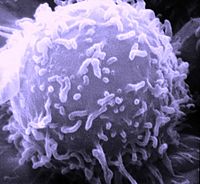Adaptive immune system facts for kids
The adaptive immune system is made of specialized cells and processes which kill pathogens or prevent their attack.
The adaptive immune system is switched on by the evolutionarily older innate immune system. This older system is non-specific, whereas the adaptive system is tailored to specific targets.
Whereas the innate immune system is found in all metazoa, the adaptive system is only found in vertebrates. It is thought to have arisen in the first jawed vertebrates.
The adaptive immune response gives the vertebrate immune system the ability to recognize and remember specific pathogens. The system mounts stronger attacks each time a particular pathogen is encountered. It is adaptive immunity because the body's immune system prepares itself for future challenges.
Contents
Layered defence
The immune system protects organisms from infection with layered defences. In simple terms, physical barriers prevent pathogens such as bacteria and viruses from entering the organism.
If a pathogen breaches these barriers, the innate immune system provides an immediate, but non-specific response. Innate immune systems are found in all plants and animals.
If pathogens successfully evade the innate response, vertebrates possess a third layer of protection, the adaptive immune system, which is activated by the innate response. Here, the immune system adapts its response during an infection to improve its recognition of the pathogen.
After the pathogen has been killed, the offspring of B and T cells continue. They are ready for a faster response next time. This is a kind of 'immunological memory'. These cells allow the adaptive immune system to mount faster and stronger attacks each time this pathogen is encountered.
| Innate immune system | Adaptive immune system |
|---|---|
| Response is non-specific | Pathogen and antigen specific response |
| Exposure leads to immediate maximal response | Lag time between exposure and maximal response |
| Cell-mediated and humoral components | Cell-mediated (T lymphocytes) and humoral (antibody) components |
| No immunological memory | Exposure leads to immunological memory |
| Found in nearly all forms of life | Found only in jawed vertebrates |
Both innate and adaptive immunity depend on the ability of the immune system to distinguish between self and non-self molecules. In immunology, self molecules are those components of an organism's body that can be distinguished from foreign substances by the immune system. Conversely, non-self molecules are those recognized as foreign molecules. One class of non-self molecules are called antigens (short for antibody generators) and are defined as substances that bind to specific immune receptors and elicit an immune response.
Functions
Adaptive immunity is triggered in vertebrates when a pathogen evades the innate immune system and generates a threshold level of antigen.
The major functions of the adaptive immune system include:
- the recognition of specific “non-self” antigens in the presence of “self”, during the process of antigen presentation (where macrophages and dendritic cells capture antigens so T cells can recognise them).
- the generation of responses that are tailored to maximally eliminate specific pathogens or pathogen infected cells.
- the development of immunological memory, in which each pathogen is “remembered” by a signature antibody. These memory cells can be called upon to quickly eliminate a pathogen should subsequent infections occur.
| Naturally acquired | Artificially acquired |
|---|---|
| Active- Antigen enters the body naturally | Active- Antigens are introduced in vaccines. |
| Passive-Antibodies pass from mother to fetus via placenta or infant via the mother's milk. | Passive- Preformed antibodies in immune serum are introduced by injection. |
Images for kids
See also
 In Spanish: Sistema de inmunidad adquirida para niños
In Spanish: Sistema de inmunidad adquirida para niños



